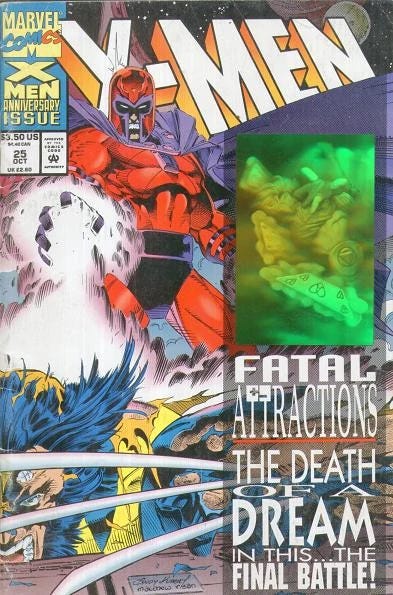What I thought:
Comic books in the 90’s were capital “W” wild. In a span of a few years the following happened:
Superman died, was replaced by four new Superman, and then returned. (The Death and Return of Superman)
Batman had his back broken by Bane, was replaced by a new Batman, that Batman went crazy, and then the original Batman returned. (Batman: Knightfall)
Spider-Man teamed up with Venom to fight Carnage, then found out his clone survived, then found out that he was actually a the clone, left as his “clone” took over, and then came back when it was revealed that he was actually the real Spider-Man and the “clone” was actually a clone. (Maximum Carnage and Maximum Clonage)
Magneto returned, the X-Men fought him, He ripped out Wolverine’s adamantium skeleton, and Wolverine left the X-Men. Then we saw the Age of Apocalypse come to be after Professor Xaiver’s time traveling son, Legion, murdered him and created an alternate reality before things returned to “normal.” (X-Men: Fatal Attractions and Age of Apocalypse)
Many of these comic books had gimmicky covers with holograms, cut out designs, and/or had the words “collector’s items” on them. Spin-off characters from the main titles got their own series and people had to snap up those first issues because they were going to be worth something some day.
Every comic book collector also had to buy Wizard Magazine to keep track of not only everything happening with their favorite character, but also to use the pricing guide in the back to know how much their collection was worth.
It was in the letter section of one issue of Wizard Magazine that I read about a company that would, for a monthly fee, buy comic books they thought would be worth money some day, and hold them for you as an investment. This is essentially a sort of mutual fund for comic books. I’m sure that you will not be surprised to know that this letter was complaining that this service was a fraud.
Then it all ended. The market was saturated with comic books and before long those “collector’s editions” of first issues were being sold for pennies on the dollar in the bargain bins. The demand for them was manufactured by the publishers, not by the fans.
Now, even to this day there are issues of comic books that are worth quite a bit of money. Recently, the first appearance of Spider-Man in Amazing Fantasy #15 sold for $3.6 million and the first appearance of Superman in Action Comics #1 sold for $5 million. The reason why these specific issues sold is twofold, 1) they are the first appearances of beloved characters and more importantly, 2) they are extremely rare. Not many copies survived being stored in the basement, mom throwing out old comic books, or just general neglect from kids passing them around.
Which brings me to NFTs and cryptocurrency. At best they seem like collector’s items to me in that they only have value among the people that want them. Which is to say that they don’t have broad appeal. I mean, I have read all the reasons why Bitcoin could be a new decentralized currency, but you can’t use it to buy groceries from Target. You can sell a Bitcoin to another collector for US dollars and then use them to buy groceries from Target.
NFTs are a whole other thing. When I see them all I can think about is that holographic cover of X-Men #25 (where Wolverine gets his adamantium skeleton ripped out.) It is somebody manufacturing a “must have item,” not something that is actually valuable or special. It’s somebody saying “you must have this” rather than people saying, “wow, I want that".”
Watch Paris Hilton and Jimmy Fallon talk about their NFTs. Does this seems like a totally organic thing or something being forced? They are trying to make “fetch” happen.
Much like how those special “Reign of the Supermen” die-cut covers went from being a super hyped collector’s edition to the bargain bins, the NFT of the first tweet from former Twitter CEO Jack Dorsey went from being valued at $2.9 million to now being “worth” less than $10,000.
This is simple economics, but the balance between scarcity and demand is what makes something valuable. This isn’t something that I learned from an economics class. Like many of my most valuable lessons, I learned it from comic books.
What I Watched:
I was a little late to Severance on Apple TV+ but it is fantastic.
I make no apologies for my appreciation of Michael Bay. In the truest sense of the word he is an “auteur.” He is back to form with Ambulance. It’s in theaters now but from what I understand will soon be on Netflix. It is about 20 minutes too long and gets pretty wild, but a fun ride all the way through.
What I read:
This article from The Atlantic is about how social media has made society bad and introduces some reforms.
Why the Past 10 Years of American Life Have Been Uniquely Stupid



